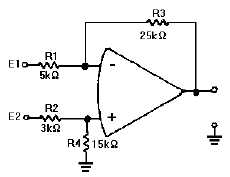17
2-44. How many inputs can a (a) difference
amplifier and (b) summing amplifier
have?
1. (a) Two only
(b) Two only
2. (a) Two only
(b) More than two
3. (a) More than two
(b) Two only
4. (a) More than two
(b) More than two
Figure 2G.—Difference Amplifier.
IN ANSWERING QUESTIONS 2-45
THROUGH 2-48, REFER TO FIGURE 2G.
2-45. THIS QUESTION HAS BEEN
DELETED.
2-46. If the amplitude of the signal at E1 is +3
volts and the amplitude of the signal at
E2 is +9 volts, what will the amplitude of
the output signal be?
1. +6 volts
2. +12 volts
3. +30 volts
4. +60 volts
2-47. If the amplitude of the signal at E1 is +6
volts and the amplitude of the signal at
E2 is +2 volts, what will the amplitude of
the output signal be?
1. +8 volts
2. +20 volts
3. -20 volts
4. -40 volts
2-48. The gain of the operational amplifier
shown in figure 2G can be determined by
using the ratio of resistance. Which of
the following ratios is correct for
determining this gain.
1.
3.
2.
4.
2-49. A magnetic amplifier can be classified as
which of the following types of
amplifier?
1. RF amplifier
2. Audio amplifier
3. Video amplifier
4. Voltage amplifier
2-50. Which of the following statements
describes the basic operating principle of
a magnetic amplifier?
1. Any power amplifier will create a
magnetic field which can be used to
increase the gain of the power
amplifier
2. The inductance of an air-core
inductor will change as the power
used by the load changes
3. A changing inductance can be used
to control the current in a load
4. Magnetism can be increased
(amplified) by changing the voltage
amplitude
2-51. What happens to the true power in a
series LR circuit if the inductance is
decreased?
1. It increases
2. It decreases
3. It remains the same
4. It increases initially and then
decreases rapidly







